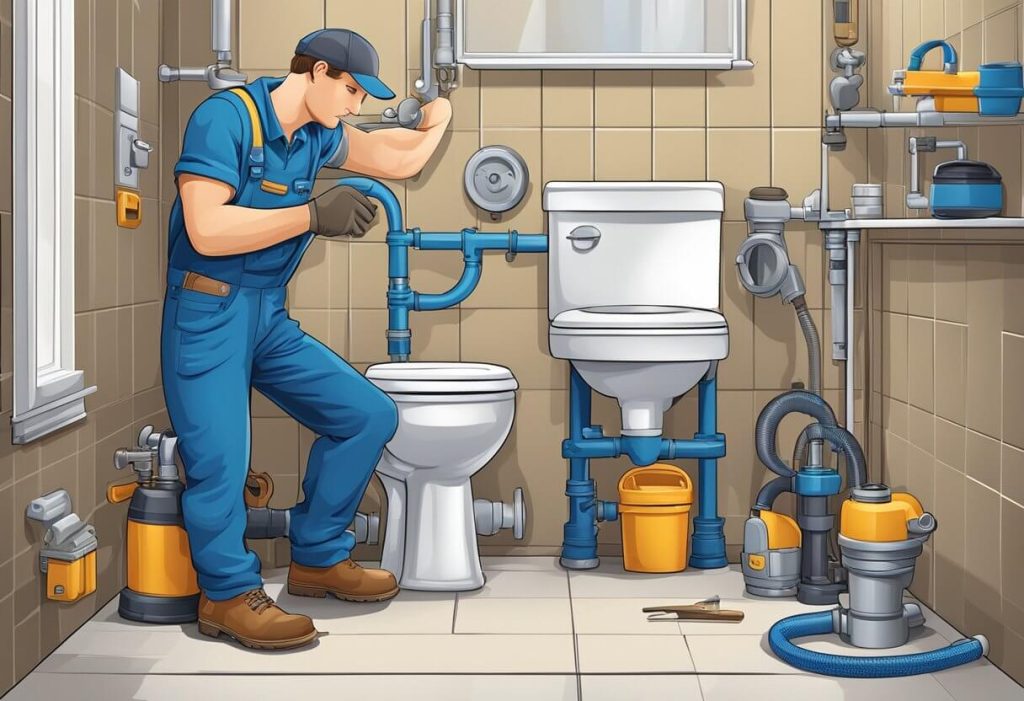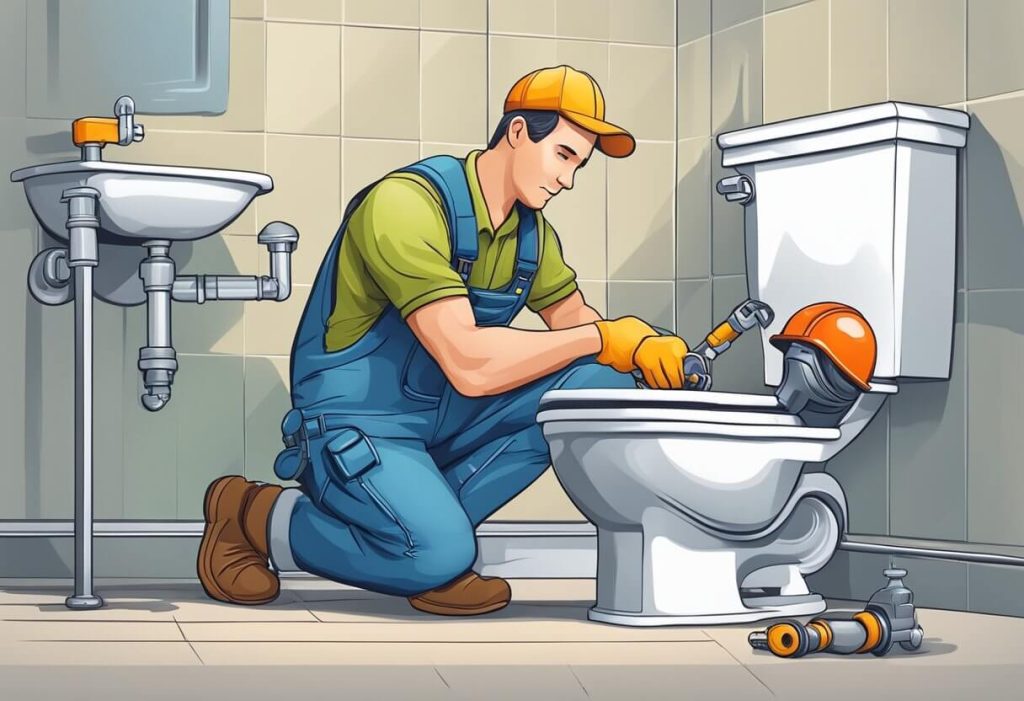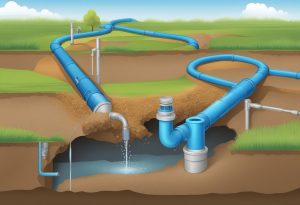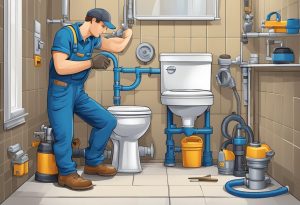Toilet repair is an essential aspect of home maintenance, as a properly functioning toilet is crucial for the comfort and hygiene of any household. Common issues with toilets can range from clogs and leaks to problems with the tank components. Timely diagnosis and fixing of toilet issues can prevent bigger problems, save water, and maintain a healthy living environment.

Homeowners should familiarize themselves with basic toilet components and common issues to be able to identify signs of malfunction and address them adequately. While some issues can be solved with simple DIY techniques, such as unclogging a toilet using a plunger, other problems might require the assistance of a professional plumber. Recognizing when to seek professional help is an essential step in maintaining a well-functioning toilet and avoiding costly damages.
Key Takeaways
- Addressing toilet repair promptly can save water and maintain a healthy living environment.
- Understanding basic toilet components helps in diagnosing common issues and deciding whether to attempt DIY fixes or call a professional.
- Expert plumbers in Malaysia offer reliable and affordable services for more complex toilet repair situations.
Diagnosing Toilet Issues
Identifying Common Problems
There are several common toilet problems that homeowners may encounter. Recognizing these issues is the first step in diagnosing and fixing them. Some of the most frequent issues include:
- Clogged toilet: A blockage in the toilet’s drainpipe prevents waste and water from flowing properly, causing the toilet to overflow or not flush completely.
- Running toilet: The water in the tank continuously flows into the toilet bowl, leading to water waste and possibly higher water bills.
- Leaks: Water leaks can occur around the base of the toilet, from the tank or in the connections between the tank and the bowl.
Each of these problems requires a different approach to diagnose and repair.
Tools for Detection
To diagnose and resolve these common toilet problems, homeowners should have a few essential tools on hand. These tools can help identify and fix issues more efficiently:
- Plunger: A plunger can help dislodge clogs in the toilet’s drainpipe, making it an effective tool for handling clogged toilets.
- Toilet auger: Also known as a closet auger, this tool can reach further into the drainpipe than a plunger to remove more stubborn clogs.
- Adjustable wrench: An adjustable wrench is useful for tightening or loosening bolts and nuts that secure the toilet tank and bowl connections, as well as sealing leaks.
- Screwdriver: A screwdriver is helpful for making necessary adjustments to the internal components of the toilet’s tank, such as the flapper or fill valve.
Using these tools, homeowners can confidently diagnose and repair many common toilet issues. Careful observation and the use of these tools will aid in detecting problems at the toilet bowl and within the tank to help maintain a well-functioning bathroom.
Unclogging Techniques
Plunger Use and Effectiveness
Using a plunger is the most common and effective method to unclog a toilet. To use a plunger, first make sure there is enough water in the bowl to cover the rubber part of the plunger. Push the plunger into the bowl and pull it out vigorously, creating a suction and pressure to dislodge the clog. Remember to keep some towels handy to wipe up any water that might splash out during the process. Plungers with a rubber flange are more effective in creating a better seal around the drain.
Alternative Methods for Stubborn Clogs
If the plunger doesn’t clear the clog, there are other methods to try:
Hot Water and Dish Soap: Pour hot (but not boiling) water into the bowl, along with a few squirts of dish soap. The hot water helps to break down the clog, while the soap acts as a lubricant to make it easier to flush away.
Toilet Auger or Snake: A toilet auger, also known as a plumbing snake, is a long, flexible tool with a rotating head that can reach deep into the drain and break or pull out stubborn clogs.
Homemade Remedies: Combining everyday household items, such as baking soda and vinegar, can create a chemical reaction that helps dissolve clogs.
In summary, attempting to clear a clogged toilet with a plunger is usually the first and most effective step. However, if the clog persists, alternative methods like hot water and dish soap, toilet augers, or homemade remedies may help. Remember to exercise caution when using any of these methods and consider calling a professional plumber if the clog cannot be resolved with these techniques.
Toilet Tank Components and Maintenance
Toilet tanks consist of several components that regulate water flow and flushing. Regular maintenance can help prevent common issues and extend the lifespan of your toilet. In this section, we will discuss the main components and their maintenance, focusing on adjusting the flush mechanism and replacing faulty valves.
Adjusting the Flush Mechanism
To ensure proper flushing, it is essential to adjust the flush mechanism periodically. The main components involved in the flushing process are the flapper, float, chain, and lever.
- Start by examining the flush valve, which is responsible for controlling the flow of water from the tank to the bowl during flushing.
- Check the flapper for any signs of wear, and make sure it is sealing properly. A worn flapper may result in water leakage and inefficient flushing.
- Inspect the float to ensure it is in the right position. Adjusting the float can help regulate the water level in the tank, impacting the flushing power.
- The chain that connects the flush handle to the flapper should be tight, but not too loose or taut.
- The lever should move freely when pressed, as this initiates the flushing action.
Replacing Faulty Valves
Faulty valves can lead to several issues, such as constant running water, overflowing, or insufficient flushing. The two main valves in the toilet tank are the fill valve and the flush valve.
Fill Valve:
The fill valve is responsible for refilling the tank after each flush. When it malfunctions, you may experience slow filling or overflowing. To replace a faulty fill valve:
- Turn off the water supply and empty the tank.
- Disconnect the water supply tube.
- Remove the old fill valve and replace it with a new one.
- Reconnect the water supply tube and turn on the water supply.
Flush Valve:
A damaged flush valve can result in a weak flush or constant running water. To replace a faulty flush valve:
- Turn off the water supply and remove the tank lid.
- Disconnect the flapper chain from the flush lever.
- Remove the old flush valve by unscrewing the locknut located underneath the tank.
- Install the new flush valve, ensuring the gasket and locknut are properly secured.
- Attach a new flapper, reconnect the chain, and test the flushing mechanism.
Regular maintenance of your toilet’s tank components can save you time and money by preventing significant issues and extending the life of your plumbing system. By keeping an eye on the flush and fill valves, as well as adjusting the flush mechanism components when needed, you can ensure a properly functioning toilet.
Repairing Toilet Seals and Joints
Seals and joints are crucial components in the overall functioning of a toilet. Ensuring that they are intact and in proper condition is essential to avoid leaks and maintain hygiene. This section focuses on fixing leaks at the toilet base and replacing wax rings.
Fixing Leaks at the Toilet Base
A common issue that can occur with toilets is leaking at the base. This typically indicates a problem with the seal or wax ring between the toilet and the flange. Here are some steps to help fix a leak at the base of a toilet:
- Turn off the water supply valve and flush the toilet to drain the water from the tank and bowl.
- Remove the bolt caps, loosening and removing the nuts on both sides of the toilet base.
- Carefully lift the toilet straight up, exposing the flange and old wax ring.
- Clean the flange and surrounding area, ensuring there is no debris or leftover wax.
- Inspect the flange for damage, such as cracks or broken areas; if damaged, consider replacing it before moving on to the next step.
- Install a new wax ring on the flange, making sure it is centered.
- Carefully lower the toilet back into place, aligning the bolt holes with the bolts.
- Tighten the nuts evenly and securely, but avoid overtightening to prevent damage to the toilet base.
- Reconnect the water supply and turn it on, then flush the toilet to check for any leaks at the base.
Wax Ring Replacement
The wax ring is responsible for creating a seal between the toilet and the flange. Over time, the wax ring may deteriorate or fail, causing leakage. Here is the process for replacing a wax ring:
- Follow steps 1 to 6 from the “Fixing Leaks at the Toilet Base” subsection.
- Confirm that the new wax ring is centered and covers the flange hole.
- Lower the toilet back onto the wax ring, applying even pressure to compress the wax and create a tight seal.
- Reinstall the nuts, washers, and bolt caps as described in steps 8 and 9 of the “Fixing Leaks at the Toilet Base” subsection.
By addressing leaks at the toilet base and replacing worn-out wax rings, homeowners can prevent common toilet issues and maintain a clean and hygienic bathroom environment.
Professional Assistance and Services

Finding the right toilet repair services is essential to ensure the best results for your plumbing needs. When dealing with toilet issues, it is important to seek the help of a professional plumber. Experienced plumbers offer proficient and efficient service, along with excellent customer service. In this section, we will discuss when to call a professional plumber for your toilet repair needs.
When to Call a Professional Plumber
Engaging the assistance of a professional plumber is necessary in several situations:
Clogged toilets: A serious clog can result in overflowing toilets, leading to damage to your bathroom flooring and potential health hazards. A professional plumber can efficiently clear the clogged toilet and restore it to proper functioning.
Leaking pipes: Toilet leaks can cause water damage to your bathroom, as well as an increase in your water bill. A skilled plumber can fix the leaks to prevent further damage and save you money in the long run.
Running toilets: Toilets that continuously run waste water and can increase your utility bills. Engaging the service of an experienced plumber can resolve this issue by fixing the internal components of the toilet.
Toilet replacement: When your toilet is beyond repair, a professional plumber can replace it with a new one, ensuring proper installation and functionality.
To ensure you receive the most efficient service, it is essential to research the plumbing company’s reputation, credentials, and customer reviews. Many professional plumbing companies offer free consultations and will provide a reasonable quote for their services.
In conclusion, always seek the assistance of a professional plumber for your toilet repair needs. They offer experienced plumbers and efficient service, ensuring that your toilet is properly maintained and your plumbing issues are resolved. Do not hesitate to contact us for professional plumbing assistance.
Frequently Asked Questions

How can I replace a damaged toilet flush chain?
To replace a damaged toilet flush chain, first disconnect the chain from the flush lever and the flapper. Then, remove the old chain, attach the new chain to the flush lever, and reconnect it to the flapper. Make sure to adjust the chain’s length to ensure a proper flush and prevent any kinks or knots.
What steps are involved in fixing a constantly running toilet?
Fixing a constantly running toilet involves identifying the root cause, which usually lies in the flapper, fill valve, or float. Check the flapper for leaks and consider replacing it if needed. Also, inspect the fill valve for damage and adjust the float to ensure the water level is appropriate. Sometimes, all it takes is a little cleaning and adjustment to fix the issue.
Can you guide me through fixing a toilet with a button flush that won’t stop running?
- Turn off the water supply to the toilet.
- Remove the toilet cistern lid.
- Disconnect the flush buttons.
- Check the flush valve for any debris or damage.
- If the valve is faulty or damaged, replace it with a new one.
- Reconnect the flush buttons.
- Turn the water supply back on and test the flush system.
What are the typical costs associated with repairing a toilet system?
Toilet repair costs can vary depending on the severity of the problem, the required replacement parts, and your location. In general, a typical repair such as fixing a leaking toilet may cost between $50 and $300. However, for a more accurate estimate, it’s best to consult with a local plumber.
How do you properly unclog a blocked toilet without professional help?
- Use a plunger: Place the plunger over the toilet’s drain hole and push down gently. Then, pull up forcefully, repeating the process until the clog is cleared.
- Apply an enzyme-based drain cleaner: These products can break down clogs composed of organic material. Be sure to follow the manufacturer’s instructions.
- Use a plumbing snake: Insert the snake into the toilet drain and crank it to break up and retrieve the clog.
What should I consider when installing a new toilet bowl, and what might it cost in Malaysia?
When installing a new toilet bowl in Malaysia, consider the size and style of the bowl, the available space in your bathroom, and whether you want a floor-mounted or wall-mounted unit. A typical toilet installation in Malaysia can range from RM200 to RM1,000, which includes both the toilet bowl and professional installation services. To save costs, look for promotions or bundled deals when purchasing a new toilet bowl.
Water Leak Underground: Causes, Signs, and Solutions
Water leaks underground can be a significant concern for homeowners, as they are often challenging to detect and can lead to costly damage if left
Seven Engineering and Professional Services: Advancing Global Expertise in Innovative and Inclusive Technology
In the rapidly evolving landscape of engineering and professional services, we see an undeniable trend towards leveraging advanced technology to empower experts around the globe.
Water Leakages Detected Malaysia: Nationwide Solutions and Prevention Strategies
Underground Water Leak Detection: Vital Approaches for Early Identification Key Insights Underground water leak detection is crucial for preventing water wastage and damage to infrastructure.

How are underground water leaks detected?
Underground Water Leak Detection: Essential Strategies for Early Discovery Underground water leaks are a pervasive issue that can lead to significant water wastage and financial

Toilet Repair: Essential Tips for Fixing Common Issues
Toilet repair is an essential aspect of home maintenance, as a properly functioning toilet is crucial for the comfort and hygiene of any household. Common

Plumbing Inspections Kuala Lumpur: Your Guide to Expert Services
When considering the purchase of a property in Kuala Lumpur, securing a plumbing inspection is a smart move that goes beyond just checking off a box. It’s
SEVEN ENGINEERING (BERLIN) GLOBAL TECH BHD
SEVEN ENGINEERING (BERLIN) INNOVATION DESIGN & SERVICES SDN BHD



